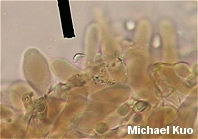| Major Groups > Gilled Mushrooms > Pale-Spored > Megacollybia > Megacollybia rodmani |

|
Megacollybia rodmani [ Basidiomycetes > Agaricales > Tricholomataceae > Megacollybia . . . ] by Michael Kuo In my area (central Illinois), Megacollybia rodmani is one of the first mushrooms to appear after the seemingly eternal lull in fungal activity following morel season, popping up eagerly after May and June rains. It is a medium-sized mushroom with a streaked-looking, gray-brown to brown or olive brown cap and a white spore print, formerly known as "Tricholomopsis platyphylla" and assumed to be the same species across North America. However, recent research (Hughes and collaborators, 2007) has changed the picture substantially so that Megacollybia rodmani is defined by its DNA and must be identified either by molecular sequencing, or by considering its range and ecology (east of the Rocky Mountains, decomposing the deadwood of hardwoods) and then eliminating two contenders with as-yet limited ranges; see the key to Megacollybia for details. Two fairly easily distinguished "forms" of Megacollybia rodmani have been described: form rodmani and form murina. The former is taller and more slender, has inconspicuous (or even absent) rhizomorphs at its stem base, features brown to olive brown shades on its cap, and has cheilocystidia that scarcely project; the latter is stout and gray-brown, with conspicuous rhizomorphs, and projecting cheilocystidia. Both forms are illustrated to the right. "Tricholomopsis platyphylla" and "Megacollybia platyphylla," in the sense of North American authors, are, in part, synonyms--especially when these names are used to refer to eastern North American material. However, Megacollybia platyphylla in Europe is an autonomous species. Description: Ecology: Saprobic; growing alone or gregariously on rotting hardwood logs or from buried deadwood; May through July; fairly widely distributed and common east of the Rocky Mountains, south through Mexico to Central America. Cap: 3-20 cm; convex when young, becoming broadly convex to flat or shallowly depressed in age; dry; brown to olive brown or pale grayish brown in form rodmani; gray-brown to gray in form murina; radially streaked. Gills: Attached to the stem broadly or narrowly; close or nearly distant; whitish. Stem: 5-12 cm long and up to 1 cm wide in form rodmani; 5-9 cm long and up to 2.5 cm wide in form murina; finely silky; whitish; more or less equal above a slightly enlarged base--or tapering slightly to apex; base attached to copious and conspicuous rhizomorphs in form murina, or with inconspicuous or even absent rhizomorphs in form rodmani . Flesh: Whitish, not changing when sliced. Odor and Taste: Taste mild; odor not distinctive. Spore Print: White. Microscopic Features: Spores 6-10 x 5-7.5 µ; smooth; ellipsoid; inamyloid. Cheilocystidia abundant; primarily clavate; to about REFERENCES: Petersen, Hughes & Lickey, 2007. (For "Megacollybia/Tricholomopsis platyphylla": Kauffman, 1918; Smith, 1949; Smith, 1960; Arora, 1986; States, 1990; Phillips, 1991/2005; Lincoff, 1992; Horn, Kay & Abel, 1993; Barron, 1999; Roody, 2003; McNeil, 2006; Miller & Miller, 2006. For Megacollybia rodmani: Hughes et al., 2007.) Herb. Kuo 06039501 (f. rodmani), 06140202 (f. rodmani), 05120706 (f. murina), 05281004 (f. murina). 06311004 (f. murina). This site contains no information about the edibility or toxicity of mushrooms. |
form rodmani:
form murina:
© MushroomExpert.Com |
|
Cite this page as: Kuo, M. (2010, May). Megacollybia rodmani. Retrieved from the MushroomExpert.Com Web site: http://www.mushroomexpert.com/megacollybia_rodmani.html |






